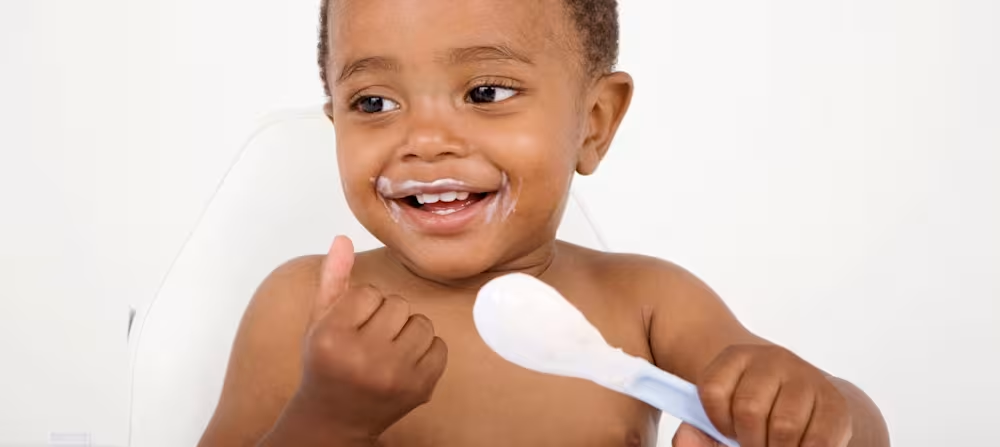Protein for kids: Best sources and how much protein my child needs
Updated Jan 02, 2026

Every parent has probably wondered at one time or another, “Is my child eating enough protein?” And it’s no wonder! A quick scroll through health headlines or social media and it’s likely you’ll see protein, protein, protein! The good news is that your child’s protein needs are likely less than you think and can be met fairly easily with a varied diet. Keep reading for all the information you need to know about protein for kids and how to choose the best sources.
What is protein?
Protein is one of the three macronutrients, the parts of food that give us energy. It is responsible for many different functions and can be found in every cell in the body. Protein helps build and repair muscles and tissue, supports immune function, and is used to make enzymes and hormones throughout the body.
It is made up of amino acids, small building blocks that come together to form proteins in the body. Some amino acids are essential, meaning they must be obtained through food, while others can be made inside your body. Additionally, you may hear proteins referred to as complete or incomplete. Complete proteins contain all the essential amino acids whereas incomplete proteins do not. This doesn’t make incomplete proteins any less nutritious or important, it just means eating a variety of foods is the best way to ensure you and your little one are getting all the amino acids you need.
Why protein is important for children
Protein is important for children because it directly supports optimal growth and development. From building muscles and tissues to keeping the immune system functioning at its best, protein helps ensure the rapid growth that happens during childhood stays on track. Additionally, adding protein to your child’s meals allows them to have more sustained energy, and balanced blood sugar levels and keeps them full longer.
How much protein should my child have?
Children’s protein needs can vary based on their age, size, or gender. However, following the recommendations set by the National Institutes of Health [] (seen below) is a simple way to make sure your child is getting the protein they need. Depending on your child’s unique health needs or how active they are, they may need more or less protein. To best determine your child’s specific protein needs, check with your pediatrician or a registered dietitian.
0 to 6 months: 9 grams protein/day - Protein at this age comes exclusively from breast milk and/or formula.
7 to 12 months: 11 grams protein/day - Protein at this age comes from breast milk, formula, and solid foods.
1 to 3 years: 13 grams protein/day - Protein at this age may look like: ½ cup of milk (4 grams), 1 tablespoon of peanut butter (4 grams), 1 scrambled egg (6 grams)
4 to 8 years: 19 grams protein/day - Protein at this age may look like: ½ cup of yogurt (4 grams), ¼ cup of nuts (5 grams), 2 oz of chicken (12 grams)
9 to 13 years: 34 grams protein/day - Protein at this age may look like: ½ cup of yogurt (4 grams), 1 hard-boiled egg (6 grams), 4 oz of salmon (24 grams)
Protein sources your child could eat
Although many people think of animal foods such as meat, fish, or eggs when it comes to protein, many foods add protein to your child’s diet. Plant-based proteins like beans, lentils, nuts, and seeds as well as dairy products are often preferred protein foods for kids as they are often easier to chew or have more likable textures.
Here are some ideas for adding protein to your child’s diet. It’s OK if they don’t like all these foods or your family doesn’t eat some of these foods. Aim to offer as many as you can that feel appropriate for your family.
Meat (beef, pork, wild game)
Poultry (chicken, turkey)
Fish
Eggs
Beans
Lentils
Cow’s milk or soy milk
Yogurt
Cheese
Nuts and seeds
Tofu
Other foods such as vegetables and whole grains contain protein as well but in lower amounts. While these foods will contribute important carbohydrates and fiber to your child’s diet, they will only add small amounts of protein and likely wouldn’t meet your child’s protein needs on their own.
Protein FAQ
Share article:
Note: The content on this site is for informational purposes only and should not replace medical advice from your doctor, pediatrician, or medical professional. If you have questions or concerns, you should contact a medical professional.
1 Sources
Share article:






